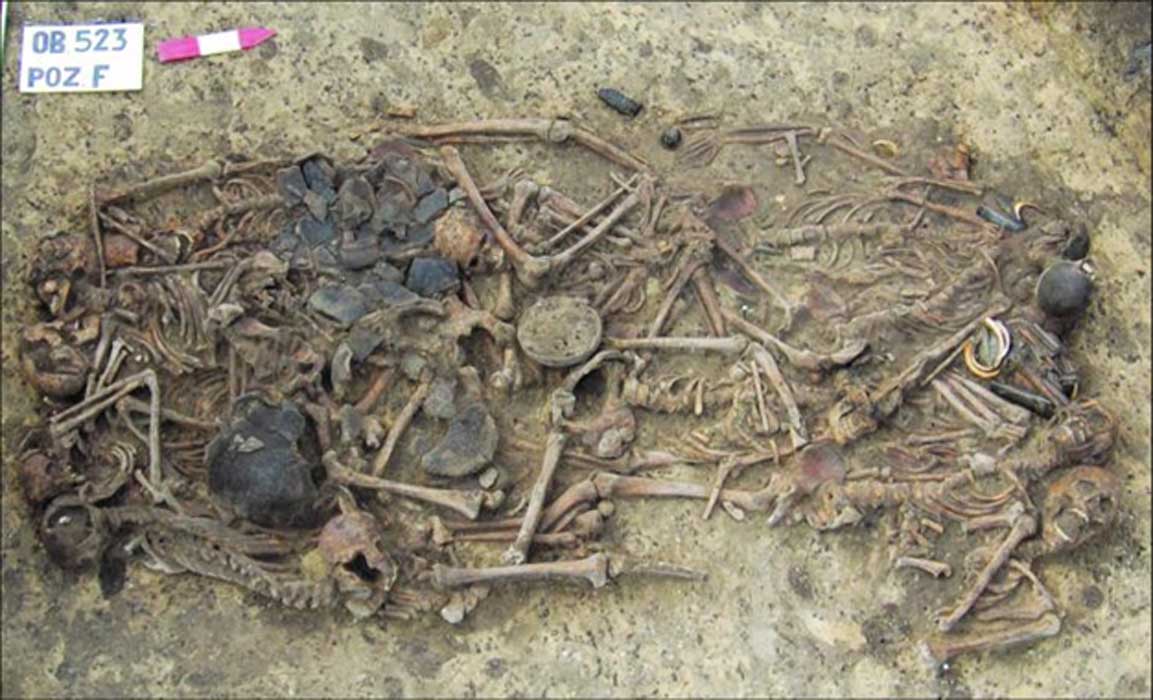5000-Year-Old Family Found In Mass Burial Was Brutally Murdered
New research published this week in the Proceedings of the National Academy of Sciences of the United States of America (PNAS) entitled “Unravelling ancestry, kinship, and violence in a Late Neolithic mass grave” is the work of a group of experts from Poland which gives details of a brutal family murder that occurred almost 5000-years-ago.
The Discovery of the Koszyce Burial
The study concludes:
“Brutal events such as the family massacre documented in the Koszyce burial may have been all too common in the unstable, tumultuous centuries at the beginning of the third millennium BC.”
What this refers to are new findings that shed light on a mass grave discovered in Koszyce, in southern Poland, by a team of Kraków archaeologists in 2011.
Dating to 5000 years ago the mass grave contained the bones of 15 people including women, teenagers, and small children - but only one man. The scientists tested DNA from the 15 bodies, and they were all found to be related, belonging to the Globular Amphora culture which emerged in Central Europe around 3400-2800 BC. According to the 1997 Encyclopedia of Indo-European Culture, “Globular Amphora culture” is the underlying culture of a Germanic-Baltic-Slavic continuum.

Map of Poland showing the location of Koszyce burial and four other group sites included in this study. (H Schroeder et al / PNAS)
Evidence of Lifestyles and Deathstyles
While we might be shocked at such a dark discovery, which really does bring up some nasty questions, the scientists called the find an ‘intriguing scene’. This is not because they are a tasteless bunch, but mainly because they get to test their skills in bringing together several disciplines including criminal anthropology. And the researchers’ goal is not only to better understand how the group lived, but equally, if not more so, how and why they died.
Polish experts have suggested the family was executed during a ceremony or even as part of ritual cannibalism because the bodies, mostly women and children, were found “lying close together, bodies and limbs overlapping” according to the paper. “All individuals had been brutally killed by blows to the head, but buried with great care,” the authors state, and artistic reconstructions of the mass grave featured in the study illustrate the entwined mass of bodies.
A technique called Genome-wide analysis is an observational study of genetic variants in different individuals looking at ‘traits’ like major human diseases, and the team of Polish scientists used this to successfully map the family correspondences between all 15 people in the grave. “Evidently, these individuals were buried by people who knew them well and who carefully placed them in the grave according to familial relationships,” they noted.
- Mass grave of possible bubonic plague victims excavated in London
- An ancient retrovirus has been found in human DNA – and it might still be active
- Remains of 3,000 of Napoleon’s soldiers found in mass grave show signs of starvation

A - Artistic reconstruction of the Koszyce burial based on phenotypic traits inferred from the ancient genomes. B - Schematic representation of the burial and pedigree plots showing kinship relations. C - kinship network based on kinship coefficients. (Michał Podsiadło / PNAS)
A report in Newsweek details that the scientists discovered “four of the individuals were brothers, but did not all share the same mother - though the similarities in the two women’s DNA suggest that their mothers may have been related.” And, the absence of older males in the grave, except for one father, led the authors to suggest that they were the ones who buried the women and children in the grave.
Battle For The Planet’s Resources
The types of injuries presented caused the authors to think that the people had been captured and executed, rather than having been killed fighting, and this, according to the scientists, “would fit the broader context of violence between competing groups at the time, in which women and children were often taken as captives.” The authors speculate that the men may have been away when their partners and children were captured and subsequently killed by a rival group.
What is known of the Globular Amphora culture is primarily derived from its burials in pits and cists. Grave offerings, including stone axes and animal parts (such as a pig's jaw) have been found among the skeletons of whole oxen. Archaeologists have even discovered pairs of cattle accompanied by grave gifts.
Because their economy oriented around the raising of a variety of livestock, evidence of settlements is thin on the ground and to date no house-plans have been excavated, leading to the conclusion that they constantly roamed the landscapes all year-round. Considering this, so often in history tribes of 60 or 80 people must have looked upon dwindling food stocks enough to feed 15 or 20 folk. And when such dire patches hit hunting cultures, and push really came to shove, the strongest ate and survived, hence we only see women and children in the sacrificial pit.

Genetic affinities of the Koszyce burial individuals and other GAC groups analyzed in this study. (A) Principal component analysis of sequenced ancient individuals. (B) Ancestry proportions based on supervised ADMIXTURE analysis. (H Schroeder et al / PNAS)
As I said in the opening paragraph; this discovery is a reminder of how good most of us have it today.
Top image: The mass grave of 15 skeletons and grave goods at the Koszyce burial. Source: H Schroeder et al / PNAS.
By Ashley Cowie



















